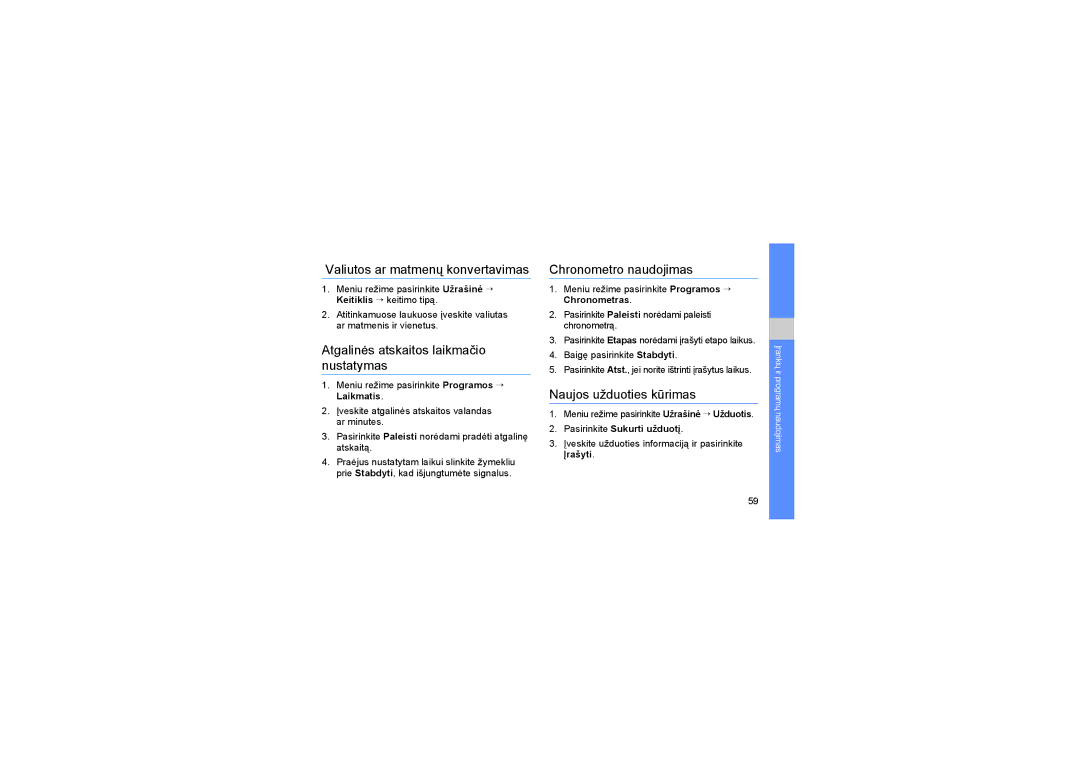Naudotojo vadovas
12 psl. rodo, kad reikia žiūrėti 12 psl
Nurodomosios piktogramos
Pavyzdžiui reiškia maitinimo
Autorių teisių informacija
Išėjimo iš meniu mygtuką
Iii
Įspėjimai dėl saugos Saugos užtikrinimo priemonės
Išpakavimas Telefono schema Mygtukai Ekranas Piktogramos
Papildomų telefonų knygos funkcijų
Pagrindinių funkcijų naudojimas
Pasaulio laikrodžių sukūrimas ir peržiūra
„Java žaidimų ir programų naudojimas
Saugokite savo klausą
Įspėjimai dėl saugos
Saugokite savo telefoną nuo mažų vaikų ir naminių gyvūnų
Saugos ir naudojimo informacija
Sumažinkite negalavimų dėl pakartotinių judesių riziką
Saugos užtikrinimo priemonės
Visada laikykitės saugaus vairavimo taisyklių
Naudokite tik „Samsung aprobuotus priedus
Elkitės su savo telefonu atsargiai ir protingai
Išjunkite telefoną būdami netoli medicinos įrangos
Page
Atsargiai elkitės su SIM ir atminties kortelėmis
Svarbi informacija apie naudojimą
Naudodami savo telefoną laikykite jį įprastoje padėtyje
Saugos ir naudojimo informacija
Tinkamas šio gaminio išmetimas
Atsakomybės apribojimas
Tinkamas šio produkto akumuliatorių tvarkymas
Saugos ir naudojimo informacija
Išpakavimas
Mobiliojo telefono pristatymas
Telefono schema
Jūsų telefono ekraną sudaro šios sritys
Mygtukai
Ekranas
Sužinokite apie ekrane atsirandančias piktogramas
Piktogramos
Pikto- Apibrėžimas grama
Įdėkite SIM kortelę ir akumuliatorių
Mobiliojo telefono surinkimas ir parengimas
Įdėkite akumuliatorių Uždėkite akumuliatoriaus dangtelį
Įdėkite SIM kortelę
Apie senkančio akumuliatoriaus indikatorių
Įkraukite akumuliatorių
Įdėkite atminties kortelę priedai
Įjunkite ne tinklo profilį
Telefono įjungimas ir išjungimas
Norėdami įjungti ne tinklo profilį, meniu režime
Pasirinkite Nustatymai → Telefono profiliai → Ne tinklo
Jutiklinio ekrano naudojimas
Valdiklių naudojimas
Prieiga prie meniu
Atverkite valdiklių įrankių juostą
Pridėkite valdiklių laukimo ekrane
Prieiga prie pagalbos informacijos
Reguliuokite mygtukų signalų garsumą
Telefono pritaikymas
Nustatykite vibravimo intensyvumą jutikliniame ekrane
Pakeiskite skambėjimo toną
Perjunkite į ar iš tyliojo profilio
Pasirinkite ekrano foną laukimo režimas
Užrakinkite telefoną
Skambinimas
Pagrindinių skambinimo funkcijų naudojimas
Atsiliepimas
Garsumo reguliavimas
Ausinių naudojimas
Žinučių siuntimas ir peržiūra
Teksto ar daugialypės žinutės siuntimas
Siųsti el. laišką
Klaviatūra Rašymas vis.ekr Rašymo langas
Teksto įvedimas
Teksto įvesties režimo pakeitimas
Kiekvieną ženklą rašykite rašymo zonoje ekrano apačioje
Jūs galite naudoti šiuos teksto įvesties režimes
Kiekvieną simbolį parašykite bet kurioje ekrano vietoje
Tekstinių ar daugialypių žinučių peržiūra
Adresatų pridėjimas ir paieška
El. laiško peržiūra
Įtraukti naują adresatą
Nuotraukų peržiūra
Pagrindinių fotoaparato funkcijų naudojimas
Fotografavimas
Vaizdo įrašų įrašymas
Muzikos klausymas
Vaizdo įrašų peržiūra
FM radijo klausymas
FM radiją valdykite naudodamiesi šiomis piktogramomis
Muzikos failų klausymas
Meniu režime pasirinkite Muzika → Muzikos grotuvas
Pasirinkite muzikos kategoriją → muzikos failą
Grojimą valdykite naudodamiesi šiomis piktogramomis
Naršymas po tinklą
Naršymas po tinklalapius
Naršykite po tinklalapius naudodamiesi šiomis piktogramomis
Pažymėti mėgstamus tinklalapius
Neatsakytų skambučių peržiūra ir rinkimas
Papildomų ryšio funkcijų naudojimas
Skambinimas paskutiniu rinktu numeriu
Sužinokite apie papildomas telefono ryšio funkcijas
Antro skambučio rinkimas
Atidėkite pokalbį ar atnaujinkite atidėtą
Atsiliepimas į antrąjį skambutį
Kelių asmenų pokalbis konferencinis skambutis
Skambinimas į užsienį
Papildomų telefonų knygos funkcijų naudojimas
Skambinimas adresatui iš telefonų knygos
Kurti vardo kortelę
Sukurkite tekstinį šabloną
Papildomų žinučių funkcijų naudojimas
Adresatų grupės sukūrimas
Tekstinių šablonų įterpimas naujose žinutėse
Sukurkite daugiaformatį šabloną
Žinutės kūrimas iš daugialypio šablono
Sukurkite aplanką žinutėms tvarkyti
Panoraminių nuotraukų fotografavimas
Papildomų fotoaparato funkcijų naudojimas
Nuotraukų serijos fotografavimas
Nuotraukų fotografavimas naudojant dekoratyvinius rėmelius
Nuotraukų fotografavimas šypsenos režime
Padalintų nuotraukų fotografavimas
Pritaikomi fotoaparato nustatymai
Fotoaparato parinkčių naudojimas
Muzikos failų kopijavimas naudojant „Samsung PC Studio
Papildomų muzikos funkcijų naudojimas
Kopijuokite muzikos failus į atminties kortelę
Daugiau informacijos ieškokite „PC Studio programos žinyne
Grojaraščio sukūrimas
Telefono sinchronizavimas su „Windows Media Player
Pasirinkite Įtraukti → Takeliai
Įtraukti
Automatinis radijo stočių išsaugojimas
Pritaikykite savo muzikos grotuvo nustatymus
Informacijos apie muziką paieška
Meniu režime pasirinkite Muzika → Rasti muziką
Meniu režime pasirinkite Programos → „Bluetooth
„Bluetooth belaidžio ryšio naudojimas
„Bluetooth belaidžio ryšio įjungimas
Duomenų siuntimas naudojant „Bluetooth belaidį ryšį
„Bluetooth įrenginio paieška ir tarpusavio ryšio nustatymas
Pasirinkite Siųsti kaip arba Siųsti URL per → „Bluetooth
Nuotolinio SIM režimo naudojimas
SOS žinutės suaktyvinimas ir siuntimas
Inscenizuoti skambučiai
Mobiliojo telefono seklio įjungimas
Balso įrašymas
Pasirinkite Įjungti po Inscenizuoti balso skambutį
Inscenizuoti skambučiai
Balso įrašų įrašymas ar atkūrimas
Balso komentaro įrašymas
Balso komentaro atkūrimas
Efektų taikymas vaizdams
Vaizdų keitimas
Nustatykite vaizdą
Įrašyti kaip
Vaizdo apkirpimas
Pakeiskite vaizdą
Vizualios ypatybės pridėjimas
Pasukite arba paverskite vaizdą ir pasirinkite Atlikta
Komentaro pridėjimas rašant ranka
Vaizdų spausdinimas
Nuotraukų ir vaizdo įrašų įkėlimas į internetą
Įveskite siuntimo informaciją ir pasirinkite Perkelti
Nustatykite dažniausių adresatų sąrašą
Failo įkėlimas
Žaidimų ir programų atsisiuntimas
„Java žaidimų ir programų naudojimas programos
Žaiskite žaidimus
Paleiskite programas
RSS skaitytuvo naudojimas
Duomenų sinchronizavimas
Peržiūrėti laikrodžio sukūrimas
Pasaulio laikrodžių sukūrimas ir peržiūra
Pasaulio laikrodžio sukūrimas
Pridėkite pasaulio laikrodį ekrane
Naujo signalo nustatymas
Signalų nustatymas ir naudojimas
Signalo sustabdymas
Signalo išjungimas
Atgalinės atskaitos laikmačio nustatymas
Valiutos ar matmenų konvertavimas
Chronometro naudojimas
Naujos užduoties kūrimas
Savojo kalendoriaus tvarkymas
Tekstinio įrašo kūrimas
Kalendoriaus vaizdo keitimas
Sukurkite įvykį
Gedimai ir jų šalinimas
Patikrinkite, ar neuždengėte telefone integruoto mikrofono
PUK kodas
Telefonas pyptelės ir blykčios akumuliatoriaus piktograma
Grupių kūrimas, 38 paieška, 29 pridėjimas
Žr. įrankiai, mob. tinklaraštis
Įkrovimas
Atskaitos laikmatis atminties kortelė 19 ausinės
Žr. skambučiai, inscenizuoti skambučiai
Garsumas Skambučio garsumas
Žr. interneto naršyklė
Žr. įrankiai, kalendorius
Žr. teksto pastabos ar balso komentarai
Nustatymas, 57 kūrimas, 57 peržiūra
Žr. įrankiai, RSS skaitytuvas
Žr. FM radijas
Įrašymas, 31 peržiūra
Komentaro sukūrimas, 60 žinutės
Žr. telefono užrakinimas
GSM mobilusis telefonas GT-S5230
Atitikimo patvirtinimas R&TTE
Lithuanian /2009. Rev

